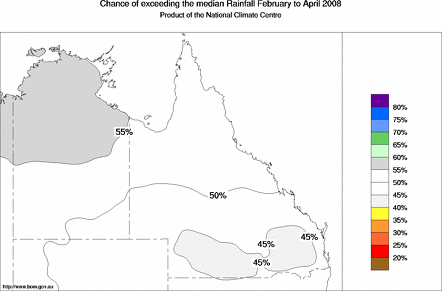Seasonal rainfall odds near 50:50 in northern Australia
The northern Australian outlook for the last three months of the wet
season (February to April), shows no strong swings in the odds towards below or
above median rainfall.
The pattern of seasonal rainfall odds across northern Australia is a result of cooler
than average waters across the equatorial Pacific in association with La Niña,
and continuing higher than average temperatures in the central to southeastern Indian Ocean.

The chances of exceeding the median rainfall over February to April are between 40
and 60% over Queensland and the NT. So the chances of being wetter than normal
are about the same as the chances of being drier.
Outlook confidence is related to how consistently the Pacific and
Indian Oceans affect Australian rainfall. During the February to April
period, history shows the effect to be moderately consistent through the
northern halves of Queensland and the NT. Elsewhere the effect is only
weakly or very weakly consistent (see background information).
A La Niña event is in progress across the Pacific Basin and
computer models indicate it will persist at least until autumn.
The 30-day value of the Southern Oscillation Index (SOI) was +18 as at 21st January.
For routine updates and comprehensive discussion on any developments please see the ENSO Wrap-Up.
|
Background Information
The Bureau's seasonal outlooks are general statements about the probability
or risk of wetter or drier than average weather over a three-month period.
The outlooks are based on the statistics of chance (the odds)
taken from Australian rainfall/temperatures
and sea surface temperature records for the tropical Pacific and Indian Oceans.
They are not, however, categorical predictions about future rainfall,
and they are not about rainfall within individual months
of the three-month outlook period.
The temperature outlooks are for the average maximum and minimum temperatures
for the entire three-month outlook period.
Information about whether individual days or weeks may be
unusually hot or cold, is unavailable.
This outlook is a summary.
More detail is available from the contact people or from SILO
(www.bom.gov.au/silo/products/SClimate.shtml).
Probability outlooks should not be used as if they were categorical forecasts.
More on probabilities is contained in the booklet
The Seasonal Climate Outlook - What it is and how to use it,
available from the National Climate Centre.
These outlooks should be used as a tool in risk management
and decision making.
The benefits accrue from long-term use, say over 10 years.
At any given time, the probabilities may seem inaccurate,
but taken over several years, the advantages of taking account
of the risks should outweigh the disadvantages.
For more information on the use of probabilities,
farmers could contact their local departments of agriculture or primary industry.
Model Consistency and Outlook Confidence:
Strong consistency means that tests of the model on historical
data show a high correlation between the most likely
outlook category (above/below median)
and the verifying observation (above/below median). In this
situation relatively high confidence can be placed in the
outlook probabilities.
Low consistency means the historical relationship, and
therefore outlook confidence, is weak.
In the places and seasons where the outlooks are most skilful,
the category of the eventual outcome (above or below median)
is consistent with the category favoured in the outlook
about 75% of the time.
In the least skilful areas,
the outlooks perform no better than random chance or guessing.
The rainfall outlooks perform best in eastern and
northern Australia between July and January,
but are less useful in autumn and in the west of the continent.
The skill at predicting seasonal maximum temperature peaks in
early winter and drops off marginally during the second half of the year.
The lowest point in skill occurs in early autumn.
The skill at predicting seasonal minimum temperature peaks in
late autumn and again in mid-spring.
There are also two distinct periods when the skill is lowest
- namely late summer and mid-winter.
However, it must always be remembered that the outlooks
are statements of chance or risk.
For example, if you were told there was a 50:50 chance
of a horse winning a race but it ran second,
the original assessment of a 50:50 chance could still have been correct.
The Southern Oscillation Index (SOI) is calculated using the
barometric pressure difference between Tahiti and Darwin.
The SOI is one indicator of the stage of El Niño or La Niña
events in the tropical Pacific Ocean.
It is best considered in conjunction with sea-surface temperatures,
which form the basis of the outlooks.
A moderate to strongly negative SOI (persistently below –10) is
usually characteristic of El Niño, which is often associated with below
average rainfall over eastern Australia, and a weaker than normal monsoon
in the north. A moderate to strongly positive SOI (persistently above +10)
is usually characteristic of La Niña, which is often associated with
above average rainfall over parts of tropical and eastern Australia,
and an earlier than normal start to the northern monsoon season.
The Australian impacts of 23 El Niño events since 1900 are summarized
on the Bureau's web site
(www.bom.gov.au/climate/enso/).
|










